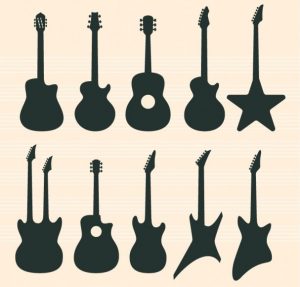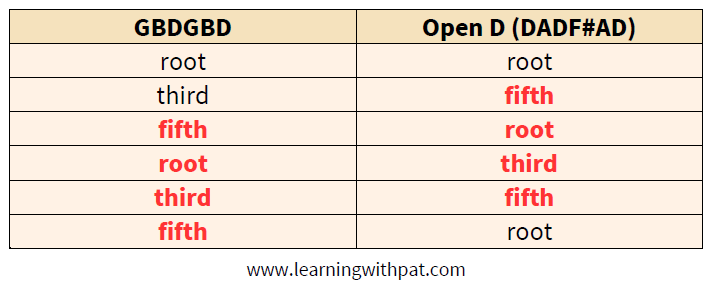
So you want to learn a new tuning and you don’t know where to start because all the dots seem to be in the wrong place 🙁
We have all been there.
Learning a new tuning or multiples tunings can quickly become confusing and overwhelming because all of a sudden your visual landmarks don’t make sense anymore.
So how to make something unfamiliar become familiar?
Well, the key is to use what you have learnt from previous tunings and apply as much as you can to the new tuning.
By finding similarities and connections between the new tuning you’re learning and previous tunings you’ve learnt, you’ll be able to quickly build a visual fretboard map for the new tuning.
To do so, the most important thing to learn is the new tuning interval layout, that is the intervals between the open strings in relation to a tonal center.
For example, in a dobro GBDGBD tuning, G, B and D are respectively the root, third and fifth of a G major chord so the interval layout of this tuning is 1, 3, 5, 1, 3, 5 (root, third, fifth, root, third, fifth).
Learning this will help you:
- Learning chords,
- Applying shapes, licks and patterns you already know,
- Learning note names
Of course, intervals are not the first thing beginners learn but i don’t think you should try and learn a new tuning if you’re a beginner anyway so if you decide to learn a new tuning, i assume you’re probably an intermediate player who already has a good grasp of a previous tuning and who knows what intervals are 🙂
So let’s discuss the first benefit of learning the tuning interval layout.
1. Learning chords
Learning chords is a powerful thing because it will help you build a fretboard map quickly.
The other benefit from learning chords is that you can learn both your chords and note names at the same time.
Let’s take an example.
You want to learn how to play in open D tuning: D A D F# A D.
If you know D, F# and A respectively the root, third and fifth of a D major chord, you can deduce that the interval layout of open D is:
1, 5, 1, 3, 5, 1 (root, fifth, root, third, fifth, root).
So when you strum the open strings, you get a D major chord.
From there you can quickly learn your straight bar major chords all over the fretboard.
For example, on the 5th fret of the 6th string, you’ve got a G note so you get a G major chord when strumming the strings on the 5th fret.
Now let’s try to use this knowledge of the tuning interval layout to apply chord shapes, licks and patterns you already know.
2. Applying chord shapes, licks and patterns
The key here is to compare your new tuning to a tuning you already know.
Let’s say you come from a dobro background and play in a GBDGBD tuning.
As we’ve seen above, the interval layout of this tuning is 1, 3, 5, 1, 3, 5 (root, third, fifth, root, third, fifth).
Compare that to open D and you’ve got the following chart:

Notice how we’ve got the same fifth, root, third, fifth pattern in both tunings: on strings 4, 3, 2, 1 in GBDGBD tuning and on strings 5, 4, 3, 2 in open D.
That means you can apply your GBDGBD shapes, patterns and licks from strings 4, 3, 2, 1 by moving them down one string to strings 5, 4, 3, 2 in open D!
You could also visualize open D tuning as a GBDGBD tuning without the lower third (the 5th string) plus a root on the 1st string.
3. Learning the note names
Learning the note names is crucial to learn scales, chords, start to improvise etc.
But it can be a daunting dask and once again we can use the power of intervals layouts and connections between different tunings to learn quicker.
If you’re lucky, you’ll already know all the note names.
For example, if you know your standard guitar tuning EADGBE and try to learn dobro in GBDGBD tuning, it will just be a matter of learning a new tuning layout with note names on strings you already know (G, B and D)
If you’re less lucky, like in the case of knowing GBDGBD and then learning DADF#AD, you’ll have to learn the note names of strings you’ve never learnt before (A and F# in this case).
But again, we can find shortcuts.
An obvious one in the case of learning the note names on the F# string would be to see it as being one semitone below G, then all you would have to is to mentally transpose the note names of a G string one semitone below…
But that could be confusing so let’s try to use your knowledge of the tuning interval layout assuming:
– you know your chords
– you know the note names of each chord
With your knowledge of the tuning interval layout, you can quickly deduce the note names of your F# string.
Since F# is the third of a D major chord , each note on this string will be the major third of the chord with its root on the 6th, 4th or 1st string (remember the 1, 5, 1, 3, 5, 1 layout).
For example:
– 5th fret is the major third of G major
– The major third of G major is B
So 5th fret of the F# string is B.
Let’s sum this up with a chart:

Also note that when you learn the notes on the A string, you only need to learn it once because once you know the note names on your 5th string, you’ll also know them on the 2nd string (since both 5th and 2nd open strings are an A).
So as you can see, it’s all about finding short paths to learn quicker and to apply what you’ve learnt from a previous instrument is a great way to do that.
And not only can you apply your theory knowledge to the new instrument but you can apply previous techniques you’ve learnt as well!
This can work both ways too: try to apply what you’ve learnt from your new instrument to other instruments you already know how to play.
Anyways, don’t forget: learning a new tuning takes time, lots of time (and work too of course)!!
So give yourself time, don’t make your head explode 🙂 and get used to how the new tuning sounds like, find out what you like about it and how you can make nice music with it, it’s all about exploring and having fun! 🙂
Want to dig deeper? Check out the related video lesson: Introduction to open D tuning
Very easy to follow.